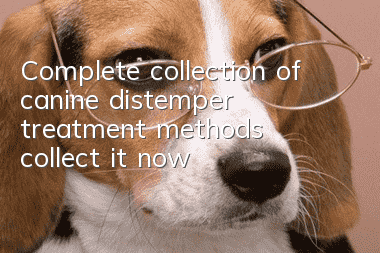Complete collection of canine distemper treatment methods, collect it now!

Canine distemper is a common highly contagious viral infectious disease, mainly caused by respiratory tract infection. The fatality rate is very high, so once your dog shows signs of canine distemper, you must take it to the doctor as soon as possible. So what are the treatment methods for canine distemper? Here are a few methods recommended for you. I hope you can use them when your dog has signs of canine distemper.
Canine distemper must be treated by a doctor as soon as possible. If you are unfortunately infected with the virus, immune serum and antibacterial drugs can be used in the early stages of the disease to cure it completely. Whether you are hospitalized or treated at home, you need to prepare a warm and dry environment for it. The most important thing is that your dog should be vaccinated when it is a puppy, avoid going out during epidemics, and never come into contact with sick dogs and their excrement and vomitus.
There is currently no effective drug treatment for this disease. When sick dogs show obvious symptoms, the prognosis is often poor. Even if a few sick dogs survive, they often have sequelae. In general, specific and symptomatic treatments are adopted to prevent secondary infections and reduce deaths. In the early stage of the disease, subcutaneous or intramuscular injection of anti-canine distemper hyperimmune serum can achieve better results. Serum dosage is 2-3ml per kilogram of body weight, applied continuously for 2-3 days. To control secondary infections, broad-spectrum antibiotics can be used, such as kanamycin, erythromycin, chloramphenicol, gentamicin, etc. To improve circulation and prevent dehydration, glucose solution and electrolytes should be supplied in large quantities. Combined with anti-inflammatory and antipyretic drugs. At the same time, cardiotonic, diuretic, and hemostatic drugs are used for comprehensive treatment. In order to protect the gastrointestinal tract, tannic acid protein and bismuth subnitrate can also be taken orally.
To treat large-volume injections of monoclonal antibodies, if it is small dogs, 2 injections a day, 4 medium-sized dogs, and 10 to 15 days, then there is no need to inject again. It is useless. Switch to human medicine, calf thymosin, which is an antiviral that enhances immunity. Of: Riba Weilin, cures illnesses (Riba is the best).
[Anti-inflammation] Start with the worst penicillins first, and then use first-generation, second-generation, and third-generation cephalosporins. Do not use them for more than 7 days to avoid drug resistance.
[Diarrhea] Fosfomycin calcium can be taken orally and Qingda can be injected into the buttocks and eyes.
[Fever] Use dexamethasone to treat the disease. If there is no fever, do not use it. It is recommended that intravenous infusion is much faster than subcutaneous injection. Orally take Qingkailing or Shuanghuolian. If you have convulsions but still have the desire to eat.
[Don’t give up] When using piracetam, phenytoin, or benzobarbital, the specific medication should be based on the dog’s symptoms and consult a local pet doctor to prepare the dosage of traditional Chinese medicine. You can use Niuhuang Angong Pills and Antelope Horn Injection, plus some neuronutrients. Adenohydrine phosphate and coenzyme A.
Be sure to remember that once the dog is healed, the medication cannot be stopped. If the dog's anemia is not cured in the later stages, it is not enough. The main purpose of this disease is to prevent secondary infection. Canine distemper usually dies from complications. The environment should be good, clean the dog cage frequently, and eat things that increase resistance.
Canine distemper is caused by the canine distemper virus in dogs (especially young ones).Dogs) are highly exposed to carnivorous animals and suffer from acute infectious diseases. This disease can occur all year round, especially in summer and autumn when it rains continuously or in cold winter. Puppies aged 2 to 6 months are most susceptible and may even die in the litter.
1. Symptoms: Generally divided into most acute, acute and chronic. The most acute type often occurs suddenly, with body temperature reaching above 40°C and foaming at the mouth. There were neurological symptoms, spinning, ataxia or generalized myoclonus, convulsions, screaming, eyes turning up, coma, and death in about 1-2 days. Acutely ill dogs generally show fatigue, loss of appetite, increased thirst, watery secretions from the eyes and nose, and a body temperature of 39.5--40°C, which lasts for 1-2 days and then returns to normal. 1-3 days later, the body temperature rises again, showing persistent fever. At this time, the appetite is lost, foaming at the mouth, and then vomiting yellow water. The eye secretions are thick, and some upper and lower eyelids are glued together or even ulcerated. Most sick dogs have diarrhea. Or it may be bloody, the mouth and tongue may be red or cyanotic, some may have ulcers on the mouth and tongue, and a lot of salivation. Generally speaking, breathing is fast, and in some cases, there is wheezing and coughing, and the nose is dry and cracked. The course of disease is 7-20 days, and chronic cases can last several months.
2. Necropsy changes: The pathological changes in the three sick dogs at necropsy are briefly described as follows: pulmonary hemorrhage, inflammatory lesions, and emphysema in some cases; hepatomegaly, blood stasis, and gray-white necrotic lesions in some cases; gallbladder enlargement and bile filling; There are strips or diffuse bleeding spots in the gastrointestinal mucosa, and the gastrointestinal contents are jelly-like; blood stasis in the spleen, and white necrotic lesions as large as sorghum grains can be seen in some cases; stasis and swelling of lymph nodes; some bladder mucosa is hypertrophic and has bleeding spots.
3. Dialectical analysis of traditional Chinese medicine: Traditional Chinese medicine veterinarians believe that exogenous diseases are diseases in which the animal body senses the evils of the six evils and is characterized by fever. The syndrome differentiation of Wei Qi, Ying Xue is the main dialectical method for exogenous diseases. When disease pathogens enter, they are generally divided into Wei Qi, Qi and Ying Xue. The disease is superficial in the health component, while the evil qi component has entered the internal organs, while the disease is more severe in the nutrient-blood component, where the evil qi penetrates deeply into the heart ying, enveloping and liver blood. Canine distemper causes elevated body temperature, diarrhea, red mouth and tongue, and neurological symptoms, which are signs that heat enters the pericardium and evil enters the nutrient blood. It should be treated by clearing away heat and cooling blood, astringing and fixing astringency.
4. Treatment
4.1 Daqingye injection 4-8 ml, gentamicin 160,000-240,000 units (individual dogs use penicillin and streptomycin for better results), intramuscular injection respectively, 1 to 2 times a day, for 3 to 5 days . For those with severe fever, add compound Ankipyrin; for those with severe asthma, add aminophylline; for those with severe diarrhea, add Hemostasis; for those with ulcerated mouth and tongue, add vitamin B2; and spray Bingboran Powder orally.
4.2 On the basis of the above, combine fluid rehydration and vitamin supplementation. 250-500ml of 5% sugar saline, 20-40ml of 50% glucose, 20-60ml of 5% sodium carbonate, one intravenous or intraperitoneal injection; and 2.5% vitamin B12.5ml, 10% vitamin C5ml respectively intramuscularly, Daily or every other day.
4.3 On the basis of the above, cooperate with the middle grassMedicinal decoction for oral administration: 20g isatis root, 15g guanzhong, 20g gardenia, 20g astragalus, 12g coptis, 15g phellodendron, 20g astragalus, 12g angelica, 15g yam, 12g atractylodes, 12g aurantium aurantium, 10g agarwood, 18g ginger pinellia, 20g of Zhuru, 15g of raw Diyu (diyu charcoal is used for blood purification), and 8g of licorice. This is the dosage for 3 puppies, decocted in water 3 times, the decoction is about 1200 ml, 1 dose per day, divided into 2-3 times by stomach tube administration or rectal infusion. Use 3 doses in a row.
5. Prevention: Sick dogs should be isolated and treated in time, kennels and sports grounds should be sprayed and disinfected with 4% sodium hydroxide solution, healthy puppies should be vaccinated with pentavalent vaccine three times within 30-90 days, with an interval of 15 days between each time, and adult dogs should be vaccinated once a year. Pentavalent vaccine.
- What are the precautions for deworming puppies?
- What are the coat colors of Australian Cattle Dogs?
- What should be done to cultivate the physical quality of puppies?
- How to stop dogs from eating poop
- Pug beauty care methods
- How to correct your dog’s bad habit of biting?
- What happens when a dog vomits? What should you do if your dog vomits?
- How to train a golden retriever to hold something in its mouth
- The benefits of neutering your dog
- Dog’s excitement



